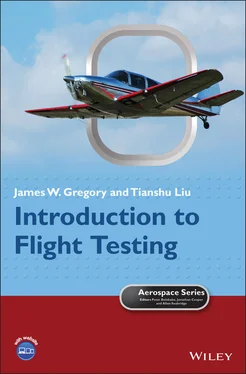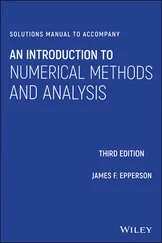4 Chapter 4Figure 4.1 Sample signal in the time domain.Figure 4.2 Sample signal in the frequency domain.Figure 4.3 Fourier series approximation of a triangle waveform.Figure 4.4 Fourier components of the sine series approximation to a triangle...Figure 4.5 Power spectrum based on the FFT of the triangle waveform.Figure 4.6 Examples of various filtering schemes applied to signals in the t...Figure 4.7 Digital representation of an analog waveform with input range of ...Figure 4.8 Digital representation of the analog waveform with input range of...Figure 4.9 Digital representation of the analog waveform with a sample rate ...Figure 4.10 Digital representation of the analog waveform with a sample rate...Figure 4.11 Digital representation of the analog waveform with a sample rate...Figure 4.12 Illustration of aliasing due to insufficiently high sample rate....
5 Chapter 5Figure 5.1 Illustration of the importance of uncertainty analysis in guiding...Figure 5.2 Illustration of bias error and precision error.Figure 5.3 Illustration of (a) high bias error with low precision error; (b)...Figure 5.4 Linear relationship between the measured and true values, which i...Figure 5.5 The Gaussian distribution and histogram of a series of measuremen...Figure 5.6 Histograms of the input variables: (a) indicated airspeed, (b) ou...Figure 5.7 Histogram of the calculated true airspeed.
6 Chapter 6Figure 6.1 Sample flight test card for an airspeed calibration test.Figure 6.2 Risk assessment matrix.Figure 6.3 XB‐70 (large aircraft, center), flying with four other GE‐powered...Figure 6.4 Sample portion of an FAA chart for navigation under visual flight...Figure 6.5 Aircraft center of gravity limits.Figure 6.6 Example of a CG envelope, showing the forward and aft limits of t...
7 Chapter 7Figure 7.1 Force diagram for level flight.Figure 7.2 Induced drag factor for varying aspect ratio and taper ratio wing...Figure 7.3 Power–velocity curve for level flight of a typical general aviati...Figure 7.4 Altitude effects on the power–velocity curve for light aircraft....Figure 7.5 Weight effects on the power–velocity curve for light aircraft.Figure 7.6 Continental IO‐360 engine.Figure 7.7 Side view of the 210‐hp Continental Motors IO‐360‐ES.Figure 7.8 Four‐stroke spark ignition cycle.Figure 7.9 Engine performance charts for the Continental IO‐360‐ES.Figure 7.10 Propeller velocity triangles.Figure 7.11 Side view of Hartzell propeller, illustrating blade twist along ...Figure 7.12 Propeller efficiency for a Hartzell 3‐bladed, 74-in. diameter pr...Figure 7.13 Flight test PIW–VIW data for determining the drag polar of the C...
8 Chapter 8Figure 8.1 The compressibility factor for airspeed correction.Figure 8.2 Correction (in kts) between EAS and CAS for a range of airspeeds ...Figure 8.3 Cutaway diagram of the airspeed indicator, illustrating how the d...Figure 8.4 The pitot‐static probe mounted on an airplane and the surface pre...Figure 8.5 Relationship between altitude error and velocity error as a resul...Figure 8.6 Effect of a wing/body on measurement of the static pressure in th...Figure 8.7 Air data boom (a) diagram and (b) installation on the nose of an ...Figure 8.8 Illustration of airspeed calibration methods of trailing bomb, tr...Figure 8.9 Sample ground track (a “cloverleaf”) for GPS‐based determination ...Figure 8.10 Vector diagram for the GPS ground velocity, true airspeed, and w...Figure 8.11 Airspeed calibration flight test results for the SR20G6, compare...
9 Chapter 9Figure 9.1 Forces acting on an aircraft in climb.Figure 9.2 Velocity triangle for an aircraft in a steady climb.Figure 9.3 Drag characteristics of a typical light aircraft.Figure 9.4 Power characteristics of a typical light aircraft. The “back side...Figure 9.5 Power required and power available characteristics for a typical ...Figure 9.6 Rate of climb variation with airspeed and altitude for a typical ...Figure 9.7 Extrapolation of maximum rates of climb to define service and abs...Figure 9.8 Instantaneous time to climb, which asymptotes to infinity at the ...Figure 9.9 Climb hodograph, illustrating the difference between best climb a...Figure 9.10 Airspeeds for best climb angle and best rate of climb.Figure 9.11 Contours of constant energy height.Figure 9.12 Energy diagram for a notional fighter aircraft, with contours of...Figure 9.13 Rate of climb flight test data compared to theoretical predictio...Figure 9.14 Rate of climb flight test data compared with level acceleration ...Figure 9.15 Comparison of maximum rate of climb flight test data with POH da...
10 Chapter 10Figure 10.1 US Airways flight 1549, moments after gliding to a water landing...Figure 10.2 Smoke visualization of wing tip vortices on a Boeing 727.Figure 10.3 Variation of induced, parasitic, and total drag with airspeed fo...Figure 10.4 Forces acting on an aircraft in glide, assuming no thrust or dra...Figure 10.5 Velocity and distance triangles for aircraft motion in glide.Figure 10.6 Sample glide hodograph for a typical light aircraft.Figure 10.7 Dependency of the lift‐to‐drag characteristics on (a) aircraft w...Figure 10.8 Glide hodograph of flight test data and theoretical data based o...
11 Chapter 11Figure 11.1 Takeoff diagram.Figure 11.2 Force diagram for takeoff ground roll.Figure 11.3 Transition distance geometry.Figure 11.4 Standard airport traffic pattern for takeoff and landing.Figure 11.5 The altitude, speed, and distance of the Cessna R182 aircraft du...
12 Chapter 12Figure 12.1 Flow separation associated with stall.Figure 12.2 Lift coefficient data for a typical airfoil (SM701, calculated i...Figure 12.3 Examples of laminar and turbulent boundary layer velocity profil...Figure 12.4 Boundary layer profiles illustrating flow separation.Figure 12.5 Stall characteristics of several canonical airfoil sections, ill...Figure 12.6 Effects of Reynolds number on airfoil stall characteristics.Figure 12.7 Stall progression for various wing planforms. (a) Elliptical win...Figure 12.8 Three examples of stall control devices on the wing of a Cessna ...Figure 12.9 Sample airspeed time history during a stall event and definition...Figure 12.10 Diagram of forces acting in equilibrium on the wing and tail in...Figure 12.11 Identification of the stall event by cross‐plotting acceleratio...Figure 12.12 Tufts on a Cirrus SR20 showing (a) attached flow, (b) trailing ...
13 Chapter 13Figure 13.1 Forces acting on an aircraft in a steady turn (inertial frame of...Figure 13.2 Forces acting on an aircraft in a steady turn (aircraft frame of...Figure 13.3 Simplified V – n diagram for a typical, normal category general av...Figure 13.4 V – n diagrams for the same aircraft at maximum takeoff weight and...Figure 13.5 V – n diagram with overlaid contours of specific excess power (ft/...Figure 13.6 (a) GPS flight test data from a DA40 in turning flight. Symbols ...
14 Chapter 14Figure 14.1 Forces and moments acting on an aircraft.Figure 14.2 Illustration of pitch moment coefficient versus angle of attack ...Figure 14.3 Forces and moments acting about the aircraft center of gravity....Figure 14.4 Depiction of the neutral point.Figure 14.5 Notional data of required elevator position (trim angle) as a fu...Figure 14.6 Measured stick deflection at various airspeed and CG test points...Figure 14.7 Illustration of the neutral point identification by extrapolatio...Figure 14.8 Aircraft coordinate axes, angles, and forces for dynamic longitu...Figure 14.9 Analytical predictions of the long‐period mode based on estimate...Figure 14.10 Z ‐Axis acceleration time record of the Cirrus SR20 phugoid mode...Figure 14.11 Spectral analysis of the time record shown in Figure 14.10 indi...
15 Chapter 15Figure 15.1 Definition of forces and moments for lateral‐directional stabili...Figure 15.2 Definition of forces and moments for lateral‐directional stabili...Figure 15.3 Calibration of the rudder and aileron control surface deflection...Figure 15.4 Static directional stability characteristics from steady heading...Figure 15.5 Static lateral stability characteristics from steady heading sid...Figure 15.6 Side force characteristics from steady heading sideslip data.Figure 15.7 Doublet rudder input to excite lateral‐directional dynamic respo...Figure 15.8 3‐2‐1‐1 rudder input to excite lateral‐directional dynamic respo...Figure 15.9 Y ‐axis acceleration (low‐pass filtered at 4 Hz) for a SR20 in Du...
Читать дальше












